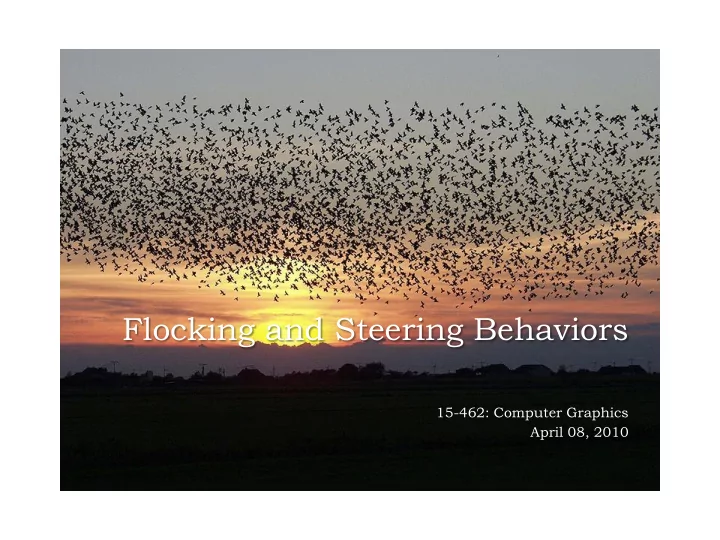

Flocking and Steering Behaviors 15-462: Computer Graphics April 08, 2010
Outline Real Flocks Our Foreflocks Particle Systems to Modified Models Flocking Behaviors Separation Cohesion Alignment Additional Steering Behaviors Obstacle Avoidance Goal Seeking Forces Orientation Project 5 Demo
Real Flocks and Schools No upper bound on size 17 mile schools of herring with millions of fish Localized reasoning Collision avoidance Centering Protection from predators Social advantages Better search
Our Foreflocks Algorithmically- simulated flocking using a “force field” implementation (SIGGRAPH Electronic Theater1985) “Flocks, Herds, and Schools: A Distributed Behavioral Model” by Craig Reynolds (SIGGRAPH1987) Defined the popular “ Boids ” model for flocking. “Steering Behaviors for Autonomous Characters” Reynolds (GDC 1999) Summarized navigational and steering behaviors (including flocking).
Basic Boids The term “ boid ” is used to describe a flock member. Can boids be particles? T o some extent, yes: A boid has an internal state (position, velocity, mass). Can be represented as a Newtonian particle in the particle system implementation previously described in lecture. Is this sufficient?
A Better Model Several differences between particles and boids: A boid is not a uniform point. Specifically, it has a complex geometric state and orientation. More complex behaviors Boid behavior is dependant on internal and external state. Internal state: particle parameters External state: knowledge about other flock members. Key idea: Local rules lead to compelling flock behavior. Boids only have a local (limited) knowledge of the flock. All rules take advantage of this local knowledge.
External State A boid also has some notion of “external” state. A neighborhood, or field of view, is generally used to describe the range of a boid’s perception. Most behavioral rules apply based on conditions in the neighborhood. Note: for Project 5, you can approximate the neighborhood as a sphere to avoid complex geometry intersections.
Steering Rules Steering behaviors formulated as rules: Concerned primarily with five (for Project 5 at least) 3 original flocking rules Separation Cohesion Alignment 2 additional steering rules Obstacle Avoidance Goal- Seeking (“seek”) Represent these as dynamic forces in a modified particle system.
Separation Pushes boids apart to keep them from crashing into each other by maintaining distance from nearby flock mates. Each boid considers its distance to other flock mates in its neighborhood and applies a repulsive force in the opposite direction, scaled by the inverse of the distance. (blackboard math)
Cohesion Keeps boids together as a group. Each boid moves in the direction of the average position of its neighbors. Compute the direction to the average position of local flock mates and steer in that direction. (blackboard math)
Alignment Drives boids to head in the same direction with similar velocities (velocity matching). Calculate average velocity of flock mates in neighborhood and steer towards that velocity.
Obstacle Avoidance Allows the flock to avoid obstacles by steering away from approaching objects. Reynolds uses the method shown below: Assume a cylindrical line of sight Compute cylinder-sphere intersection and veer away from any objects in path. Note: for Project 5, this is extra credit.
Goal Seeking Drives the flock in the direction of a target/goal. Each boid determines the direction to the goal and then steers in that direction (Note: this is basically the same as cohesion).
Force Ordering Scheme Behaviors can be assigned priorities (in order of increasing priority): Alignment Cohesion Goal-seeking Separation Obstacle Avoidance Forces can be given priority (higher priority forces can cancel out lower priority ones). Note: for Project 5 combine these into a force accumulator and integrate! Simple (potentially cleverer ways of combining forces)
Orientation One last thing to consider is orientation. Since a boid has a (generally) non-uniform geometry, we want it to change orientation and smoothly display behaviors, such as banking. For banking, we want to adjust the object’s roll (modify local x, y axes). To solve for the new up-vector (y-axis), we take a weighted sum of the resultant acceleration (due to centrifugal force and gravity) and the previous up-vector. (blackboard math) Note: for project 5, you will be required to handle banking.
Project 5 In summary, Project 5 is an interactive simulation of the boids flocking model. Requirements: Implement a modified particle system. Implement steering behaviors as dynamic forces. Implement banking. Make it interactive! Will be out later today!
Project 5 Demo Any questions?
Sources Flock Pictures: http://en.wikipedia.org/wiki/File:Sort_sol_pdfnet.jpg http://farm1.static.flickr.com/216/492878471_52af7db598_o.jpg http://farm1.static.flickr.com/184/373513163_420bc6fe69_b.jpg Paper Resources: http://www.red3d.com/cwr/steer/gdc99/ http://www.red3d.com/cwr/boids/
Recommend
More recommend